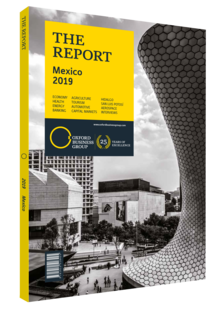Alejandro Díaz de León, Governor, Banco de México: Interview

Interview: Alejandro Díaz de León
What internal and external factors contributed to Mexico’s economic slowdown, and what monetary policies can counterbalance their effects?
ALEJANDRO DÍAZ DE LEÓN: The latest growth forecast from Banco de México (Banxico) estimates GDP growth to range between 0.2% and 0.7% for 2019, and between 1.5% and 2.5% in 2020. The forecast for 2019 reflects, in part, that during the first half of the year growth came in below expectations as a result of a weaker domestic aggregate demand. Consumption in particular has been slowing since the latter part of 2018, and investment has been on a downward trend for several quarters. While different factors can explain this performance, a key element has been an environment of uncertainty caused by global trade policy in general and our trade relationship with the US in particular. Although GDP growth is expected to gradually pick up in the coming quarters, a public policy agenda that fosters greater confidence, as well as the consolidation of a price stability environment, are needed to increase investment and sustain consumption.
Which strategies have been proven to contain upward pressures and control inflation?
DÍAZ DE LEÓN: Since mid-2014 the Mexican economy has faced a sequence of negative shocks. These have implied a tighter external financing constraint and required a reduction in the current account deficit. In addition, as the balance of trade in oil has shifted from a surplus to a deficit, a depreciation in the real exchange rate was necessary to adjust the economy to this new environment. In this regard, the flexible exchange rate regime has played a key role as a shock absorber. In particular, several inflationary pressures materialised, causing headline inflation to reach 6.8% in December 2017, the highest figure since 2001. The macroeconomic policy response involved a two-step approach: fiscal consolidation and a monetary policy focused on price stability. With regard to monetary policy, Banxico increased the policy rate from 3% in December 2015 to 8.25% in December 2018 as a measure to address inflationary pressures and keep expectations well anchored. In August and September 2019 the governing board lowered the policy rate, which currently stands at 7.75%. This decision took into consideration a number of factors, including declining headline inflation, an increase in the negative output gap, as well as the recent performance of external and domestic yield curves.
How would you characterise the health of Mexico’s banks in light of increasing uncertainties?
DÍAZ DE LEÓN: Several indicators illustrate the health and resilience of Mexico’s banking system. In the last decade bank credit to the private non-financial sector has increased from 14% to 20% of GDP, without showing signs of excessive growth in any given sector. Its composition has thus remained steady, while delinquency rates have not increased. In June 2019 all commercial banks complied with the minimum required capital adequacy ratio (CAR) of 10.5%, while the industry CAR averaged 15.7%. In addition, Banxico’s “Financial Stability Report” published in June 2019 showed the results of several stress tests spanning 2019-22 with the following scenarios considered: a contraction of aggregate demand; a deterioration of Mexico’s sovereign risk rating; and the absence of a North American trade agreement and the imposition of tariffs. Under these stress tests, as of March 2019 the system had adequate CARs and sustainable business models, allowing it to leverage ratios above regulatory minimums. In addition to this, regulation reduces commercial banks’ exposure to exchange rate risk by setting an upper limit for uncovered foreign currency positions. Current regulation allows banks to maintain a foreign uncovered position below 15% of their basic capital. Over the last 10 years credit in foreign currency has been less than 15% of total credit.
You have reached the limit of premium articles you can view for free.
Choose from the options below to purchase print or digital editions of our Reports. You can also purchase a website subscription giving you unlimited access to all of our Reports online for 12 months.
If you have already purchased this Report or have a website subscription, please login to continue.

